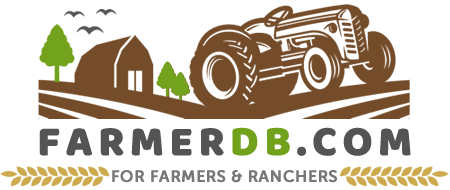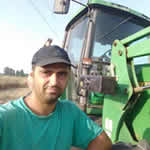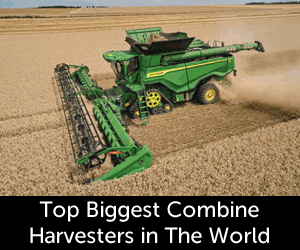Charbray is a domestic beef cattle breed that was developed by crossbreeding French Charolais cattle with American Brahman cattle.
The genetic makeup of Charbray cattle is 5/8 Charolais and 3/8 Brahman.
It was first developed in the 1930s in the United States and was later introduced to Australia in 1969, where it was further improved using new technologies such as artificial insemination. The goal was to create a strong, fast-growing breed that could survive in hotter climates.
This breed is popular in the United States, especially in southern states like Texas and Louisiana, as well as in Australia, particularly in Queensland and New South Wales. It is also found in South America and Mexico.
Charbray cattle must have between 25% and 75% Brahman influence for registration with the Charbray Society of Australia Ltd. (see refs.) This flexibility in breeding ratios ensures better adaptation to different environmental conditions.
Contents
Characteristics
Color
The color of these cattle can range from light red to a cream-colored coat.
This variation occurs due to the percentage of Charolais and Brahman genetics in an individual animal.
- If the Charolais percentage is higher, the cattle tend to have a light cream, pale yellow, or off-white coat.
- If there is a higher percentage of Brahman genes, the cattle may develop a light red or golden hue.
Dark-coated cattle do not meet breed standards and are not accepted by breed associations.
Skin
The skin is pigmented.
Coat
The coat is smooth and short, while their hide is loose and pliable.
Head
The head of Charbray cattle is wide, with eyes that are well-shielded, a firm underjaw, and a broad muzzle. Their ears vary in shape, being either straight or slightly drooped.
Horns
Charbray cattle can be horned or polled.
As with color, genetics play a role as well.
- Horned: This characteristic comes from Charolais ancestry, as Charolais cattle are horned.
- Polled: Polled cattle inherit this trait from certain Brahman bloodlines or selective breeding for polled genetics.
Dewlap
Charbray cattle inherit the Brahman’s signature loose skin, with an excessive dewlap hanging around the underside of the throat, helping them adapt to hot climates.
Body
They have a well-rounded ribcage and full, well-developed shoulders that connect to the back. The back is strong and level, extending to a slightly rounded rump. The hips are broad, while the tail is well-positioned and aligns with the rest of the body structure.
Legs
The legs are of moderate length, featuring strong hocks and short pasterns.
Underline
They have a neat and tidy underline, with a bit of looseness that does not compromise their structure.
Testicles, Udder, Teats
The testicles, as well as the udder, are well-developed. The udder has medium-sized teats that are evenly placed.
Size
These cattle are large in size, with an average height of 65 inches (165 cm) for males and 63 inches (160 cm) for females.
Lifespan
This breed has a lifespan of 10 to 15 years, which is a solid longevity range for beef cattle.
Growth Rate
How fast do they grow?
With genetics from Charolais, Charbray cattle grow rapidly, reaching weight gains of more than 2.2 lbs (1 kg) per day.
Weight
Having a good size, these cattle also score high in terms of weight.
A mature male can weigh between 2,205 to 3,638 lbs (1,000 and 1,650 kg), similar to a Charolais bull.
Females, as usual, are slightly smaller but still maintain a solid weight of 1,543 to 2,646 lbs (700 to 1,200 kg).
The calf’s birth weight is relatively low, which is a key characteristic of the breed, ranging from 77 to 88 lbs (35 to 40 kg).
Slaughtered Time
They are ready for slaughter at 12 to 15 months old, reaching a weight of 1,102 to 1,433 lbs (500 to 650 kg) in a grass-fed system and up to 1,543 lbs (700 kg) if grain-fed.
Their carcasses are classified as Yield Grade 1 and 2, meaning they require little to no fat trimming and provide a high percentage of lean, saleable meat.
Temperament
The temperament of these cattle, like many of their other characteristics, depends on genetics.
Cattle with more Charolais influence are docile and manageable, displaying a calm temperament. On the other hand, those with a stronger Brahman ancestry may have a moderate temperament, showing moments of calmness but also occasional unpredictable reactions.
Some breeders note that bulls can be energetic, and in some cases, they may attempt to jump fences or escape. Cows can also become defensive when protecting their calves.
For the most part, these cattle are alert, attentive, and responsive, but they are not aggressive unless provoked. They adapt well in herds, as consistent interaction helps reduce dominance-related stress.
They graze naturally but do not move excessively, only enough to find good pasture. These cattle also do not compete aggressively for feed, so when fed at feeding stations, they remain calm and wait their turn.
If you want to minimize unpredictable behavior in this breed, you can start training them from a young age. In this way, you establish trust and build habits that will reduce unwanted behaviors.
Meat
This breed is mainly appreciated for its high carcass yield, which is understandable given its large size.
The meat itself is not considered high quality because it is mostly lean and has minimal intramuscular fat. Therefore, it does not reach the higher standards of more marbled meats, such as Angus.
Despite this, it still scores moderately in terms of tenderness and has a mild, clean beef flavor.
Its lean composition makes it a good choice for markets focused on low-fat, health-conscious eating.
Raising
Feeding
These cattle are versatile and can eat pasture, forage, and supplemental feed. This gives you the opportunity to adapt their diet in a way that helps you achieve the final result you want: grass-fed, grain-fed, or grain-finished.
If you want to raise grass-fed cattle, you have to feed them pasture and forage.
What you can do is prepare your pasture with high-quality grasses like Bermuda grass, ryegrass, fescue, Timothy grass, or other native pasture and just let them graze by themselves.
You can also add legumes like alfalfa or clover for more protein intake and energy. During times of low forage availability, you can replace fresh grass with hay and silage. Since they have good feed conversion, they develop well on this kind of diet, achieving good weight and muscle.
For a grain-fed diet, you can use some of the common grains like corn, barley, wheat, and sorghum.
They will, of course, grow faster than on a grass-fed diet, and their meat will be slightly more marbled.
Another approach you can choose is to finish the cattle with grains. This is a combination between grass-fed and grain-fed, with grain being added in the final 90 to 150 days before slaughter to enhance meat flavor and marbling.
No matter the approach you take, you need to also offer them calcium, phosphorus, magnesium, and salt blocks, along with fresh water at all times.
Environment
The best environments for this breed are those that provide access to pasture or free movement. Extensive grazing and semi-intensive systems are good options, as they allow cattle to roam freely and sustain themselves on grass in large pastures.
You should avoid keeping them in confined or enclosed spaces for too long, as this can cause stress or health issues.
Climate
These cattle should be raised only in warm or hot climates. They are genetically adapted to live in these conditions and are not suited for cold climates or temperate regions with extreme seasonal variations.
There are also several disadvantages to raising them in colder conditions. First, since they don’t handle the cold well, they will need a proper shelter. Additionally, to keep them at a good weight, you’ll have to provide extra forage or grain to help them maintain body temperature. These factors increase costs and require more management.
Shelter
Given that they should mostly be raised in warm and hot climates, they do not need a full shelter or barn but only a simple structure to provide them with shade and protection from the sun.
You can arrange an area with more trees that could provide shade or an open-sided barn to allow them to go there and rest. This break from the sun reduces heat stress, as they know exactly when it is too much for them, and they will naturally go and look for shade.
Since they are not well-adapted to cold weather, if you decide to raise them there, you need to have a fully ventilated barn and dry bedding to keep them warm and comfortable.
How many cattle per acre?
You need at least 4 acres per Charbray cow under good pasture conditions. Due to their large size, they tend to consume more forage than smaller cattle.
If the pasture quality is poor or there is insufficient rainfall to support grass growth, the required acreage increases to up to 10 acres per cow.
Keep in mind that this number is influenced not only by pasture quality but also by soil fertility, climate, the diet provided to the cattle, and management practices.
Breeding
Charbray cattle have good fertility, and breeding can be done through natural mating without any issues.
They also reach maturity early in life, so once the females are 14 to 17 months old, you can start breeding. They will have their first calf around 2 years of age.
The gestation period is not different from other cattle, ranging between 275 to 290 days. These cattle rarely need assistance during calving because the birth weight is low, but it is always good to be present and monitor, especially during first calving.
After calving, the females quickly take on their role and nurse the calf, while also providing a good amount of milk.
The males, even though they are not an F1 crossbreed, are used in breeding programs due to their good fertility and strong traits.
Some of the crossbreeding options with a Charbray bull are:
- Charbray x Angus
- Charbray x Hereford
- Charbray x Brahman
Terminal vs. Maternal
They are often used in terminal crossbreeding programs due to their fast growth, high carcass yield, and very good meat quality, but they are not strictly a terminal breed.
Health Issues
These cattle are hardy and even disease-resistant to some common cattle issues, such as parasites and heat stress, due to their Brahman genetics.
Why should you raise it?
If you are a homesteader looking for a large cattle breed that can achieve good weight in hotter climates, Charbray is a great choice. Their versatility makes them ideal for homesteads without requiring significant effort or high costs to raise. Since they graze efficiently and do not require shelter, they are a worthwhile investment for a strong carcass yield at the end.
They are well-suited for both small and large-scale farming due to their ability to adapt to intensive systems and their calm behavior, especially in terms of feed competition.
Their early growth, early finishing, and early maturity are valuable traits that help generate profit in a shorter time compared to raising other cattle breeds.
Advantages
- Fast growth rate
- High carcass yield
- Good feed efficiency
- Great mothering skills and milk production
- Low birth weight
- Versatile feeding options
- Adaptable to various systems
- High fertility
- Good hybrid vigour for crossbreeding
- Heat and parasite resistance
Disadvantages
- Not well-suited for cold climates
- Need large areas for grazing
- Bulls can be energetic
- Potentially overprotective mothers
- Moderate fat marbling
References
- The Charbray Society of Australia Limited link
Do you have any experience with the topic discussed here?
Would you like to improve the information shared and contribute your practical knowledge on the subject?
Your real-world experience as a farmer or rancher could greatly benefit other members, and the community would deeply appreciate your contribution.


